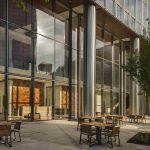What is Fire Protection Engineering?
“UL [Underwriters Laboratories] says that 30 years ago, you had up to 17 minutes to escape a house fire, but today’s homes burn faster. Why?…synthetic building materials and furnishings burn at a much faster rate than the natural products used decades ago.” — Elisabeth Leamy[1]
Stop reading this article and take a moment to look around you. How many of the objects within your view are made from synthetic materials rather than wood or cotton? Do you think you would have enough time to get out in the case of a fire? Today’s schools teach students that their family fire safety plans should get everyone out of the house in under three minutes or 14 minutes less than decades before.
What are the basic elements of a fire protection system?
Fire detection consists of the alarms that warn building occupants and authorities of a situation. Some alarms are triggered by the presence of smoke, others detect heat, and still others are the iconic red manual switches that everyone recognizes. Warnings to occupants can come in the form of any combination of strobe lights, bells, or voice commands. Each alarm should also have a backup power supply to ensure it is able to operate in any emergency situation.
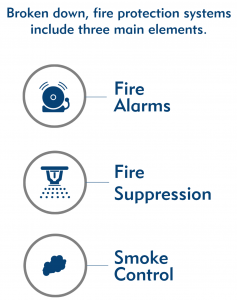 Fire suppression includes equipment such as sprinklers, standpipes, and other associated piping systems. To the average person, the only noticeable part of the fire sprinkler system is the sprinkler heads and even those can be difficult to spot depending on the type of sprinkler head. A concealed style completely hides the sprinkler head with a cover plate and is preferred when trying to minimize impact on building aesthetics. Exposed and recessed sprinkler heads are what most people would recognize as being part of a building’s fire sprinkler system.
Fire suppression includes equipment such as sprinklers, standpipes, and other associated piping systems. To the average person, the only noticeable part of the fire sprinkler system is the sprinkler heads and even those can be difficult to spot depending on the type of sprinkler head. A concealed style completely hides the sprinkler head with a cover plate and is preferred when trying to minimize impact on building aesthetics. Exposed and recessed sprinkler heads are what most people would recognize as being part of a building’s fire sprinkler system.
Smoke control is also critical when it comes to a fire emergency because smoke often causes more fatalities than burns do and causes further damage to the building.[2] An efficient smoke control system can help address both of these concerns by keeping smoke from spreading throughout the building and giving evacuees a clear escape route. These systems often include pressurizing certain areas of the building to enable smoke venting or containment.
Doesn’t water cause damage?
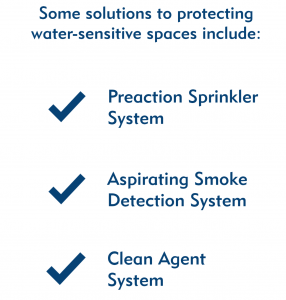 Certain areas, such as data centers, have sensitive materials or equipment easily damaged by water. In some cases, water from the fire protection system could result in more damage than the fire itself; however, building code requires water-based sprinkler systems to protect spaces. Fortunately, there are several means available to limit this risk.
Certain areas, such as data centers, have sensitive materials or equipment easily damaged by water. In some cases, water from the fire protection system could result in more damage than the fire itself; however, building code requires water-based sprinkler systems to protect spaces. Fortunately, there are several means available to limit this risk.
First, a double interlock preaction sprinkler system (a type of dry-pipe sprinkler system) can be used, which does not allow water in the piping above the sprinklers until there is both smoke and heat detection at levels that verify a fire event is underway. Next, an aspirating smoke detection system can be used to provide extremely early warning at the start of a fire event to notify trained personnel to investigate and possibly solve the situation before any active protection systems are triggered.
Additionally, a clean agent system may be provided where a chemical that does not react with electronics is discharged at the early stages of a fire event to control the situation before the sprinkler system can activate. There is also new technology coming to the market that reduces water droplets to the point where they do not conduct electricity but will fight a fire, so while many aspects of fighting fires have not changed, there are always new advances being made.
What are some special challenges?
All projects have some special aspect, and those unique aspects generally affect the fire protection system designs. While these systems are essential for protecting properties and providing life safety, they also need to work with the building’s aesthetics and provide functionality that meets the owner’s needs. For example, in spaces like hotel and casino lobbies, the fire sprinkler protection needs to blend into the surroundings and remain invisible until required during a fire event. Fire protection in retail distribution centers, on the other hand, must be designed with more of the space function in mind to minimize downtime and damage from a fire event.
Mixed-use facilities are a prime example of a structure where it is important to work with the owner to provide a system that will meet their needs. These spaces need to be flexible enough to switch between restaurant seating areas, production kitchens, clothing stores, entertainment venues, and more, and the fire protection needs to be able to adapt accordingly. Sometimes, this includes a sprinkler arrangement that can operate in most venues with minimal changes, or other times, it may be better to arrange the system so that it can be easily removed and replaced for large-scale redesigns. Neighboring tenant spaces should also be considered whenever possible, leading to an infrastructure design where shutting down one space for renovation will not affect other active businesses.
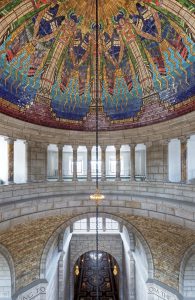
The Nebraska State Capitols rotunda features stunning and sensitive artistry.
Historical buildings come with many challenges of their own due to age, the use of outdated systems, and the often-tight requirements placed by organizations such as the National Register of Historical Places. Many of these buildings also feature artwork or artifacts that are especially sensitive to environmental damage – environmental damage that can come from water, smoke, or fire.
The Nebraska State Capitol, which was originally constructed in the 1920s, provides a perfect example of this. Alvine Engineering worked closely with the Office of the Capitol Commission and the State Fire Marshal to find solutions that best protect the public while minimizing the impact on the architecture. Offices, mechanical and storage rooms, and public spaces with minimal architectural ceiling features were designated to be protected using wet-pipe fire sprinkler systems. Meanwhile, preservation areas with ornate architectural features were designated to use an aspirating smoke detection system to provide the fire department with advanced warning while omitting fire sprinkler protection. This approach provided active life safety protection in the majority of the building while allowing for ornate spaces to be very closely monitored with minimal installation impact.
How high can it go?
A fun challenge in fire protection engineering is high-rise design. This type of space adds standpipe and fire pump designs to the project. Standpipe systems are large pipes, generally located in the stairways, with hose valves provided for the fire department so they do not have to route hoses all the way up the building from the fire trucks. This way they only have to carry one or two hoses up to the floor of the fire event, allowing them to better help occupants and fight the fire.
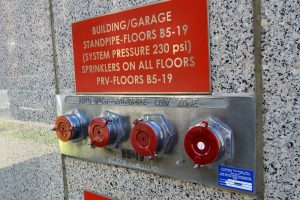 The water pressure available from the city supply is rarely capable of serving the upper floors of a high-rise, so fire pumps must be designed to support the standpipe systems. However, if the pressures get too high, the system can become dangerous for fire fighters. As fire protection engineers, we need to provide a system design that remains in a safe range all the way up and down the building. This can sometimes lead to two or three fire pump and standpipe systems in very tall buildings because the systems low in the building are repeatedly boosted as they progress up. This also means all equipment needs to be connected to and communicate with each other to provide the necessary water supply.
The water pressure available from the city supply is rarely capable of serving the upper floors of a high-rise, so fire pumps must be designed to support the standpipe systems. However, if the pressures get too high, the system can become dangerous for fire fighters. As fire protection engineers, we need to provide a system design that remains in a safe range all the way up and down the building. This can sometimes lead to two or three fire pump and standpipe systems in very tall buildings because the systems low in the building are repeatedly boosted as they progress up. This also means all equipment needs to be connected to and communicate with each other to provide the necessary water supply.
Occasionally, there have been a few projects where the building height exceeded the capability of the fire department’s pumper truck, which is used to provide backup in case the building’s fire pump does not operate properly. In these cases, we work with the fire marshal to provide an independent water supply for these upper levels by installing water storage tanks, and sometimes redundant fire pumps. We also coordinate with the structural engineer to make sure their design will support 40,000 gallons of water nearly 800 feet up the building, and with the architect to find space for the equipment without taking away from the owner’s needs for those floors.
Finally, we provide additional redundancy for the fire protection system by designing the tanks so they can be filled from both the domestic water system and the fire protection standpipe system lower in the building. Fire departments appreciate when they are included in the discussions for these complicated situations, and we work to make sure they are confident that they will have a reliable means of fighting a fire so they can focus on helping people and saving lives.
Where can I learn more?
To learn more about the special challenges to protecting historical buildings, such as the Nebraska State Capitol, read “What is Historical Preservation Engineering?”
Many healthy building initiatives are also calling for a return to using natural building materials and furnishings to encourage a connection with nature. Find out more about healthy buildings in “What is the WELL Building Standard™?” and how it can be applied in “What Does a WELL-Designed Building Look Like?”
Read the full article “House fires burn much faster than they used to. Here’s how to survive.” featured on the Washington Post website.
This short video provides a very real reminder of the danger fire poses, especially to those unable to take care of themselves such as the elderly, the very young, and pets. While residential spaces in mixed-use buildings and other commercial living areas may already benefit from fire sprinklers, the second half of the video showcases the benefits of fire sprinklers in homes. Again, many owners are concerned with associated water damage; however, a single sprinkler will typically discharge 15 gallons per minute, while the fire hose used by the fire department will typically discharge 250 gallons per minute.
Works Cited
[1] Leamy, E. (2017, November 21). House fires burn much faster than they used to. Here’s how to survive. The
Washington Post.
[2] Tennessee State Fire Marshal’s Office. (2019, April 30). SFMO: Smoke Inhalation is More Dangerous than Burns in Home Fires. Retrieved September 18, 2020, from Tennessee State Government: https://www.tn.gov/commerce/news/2019/4/30/sfmo–smoke-inhalation-is-more-dangerous-than-burns-in-home-fires.html

About the Author
Nick Bernard is a licensed fire protection engineer at Alvine Engineering with over 17 years in the industry and is certified NICET Level III in Automatic Sprinkler Layout. Nick is also an active member in organizations including the National Fire Sprinkler Association (NFSA) and the Society of Fire Protection Engineers (SFPE), where he has served on the local chapter board for over 5 years and recently became President Elect. He has designed fire protection systems for projects such as River Point in Chicago, the Nebraska State Capitol in Lincoln, and Northwestern Mutual Headquarters and Community Amenities in Milwaukee.



